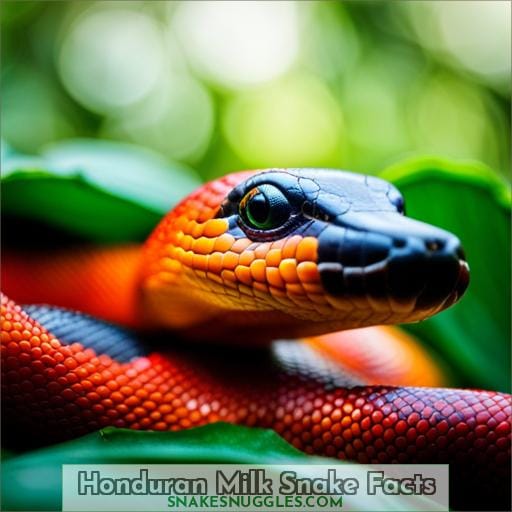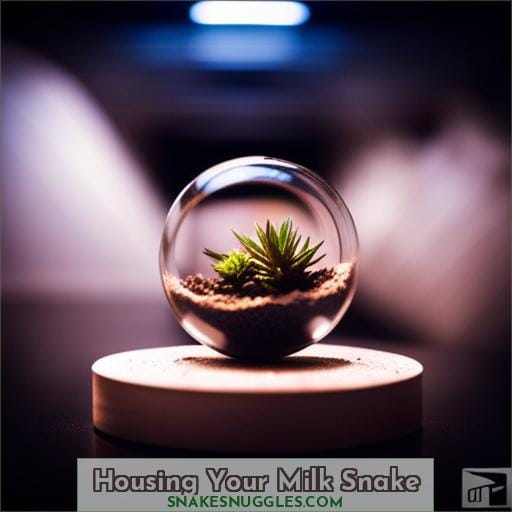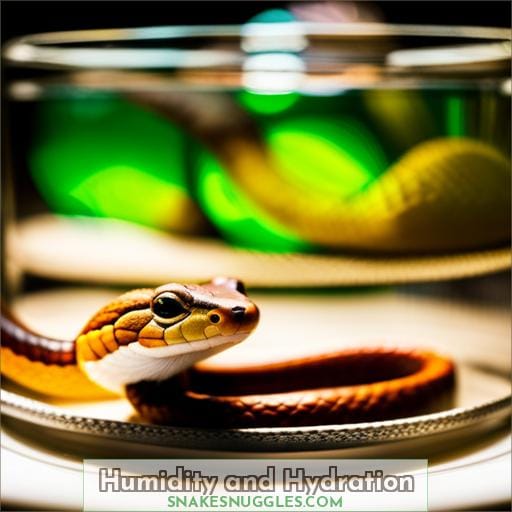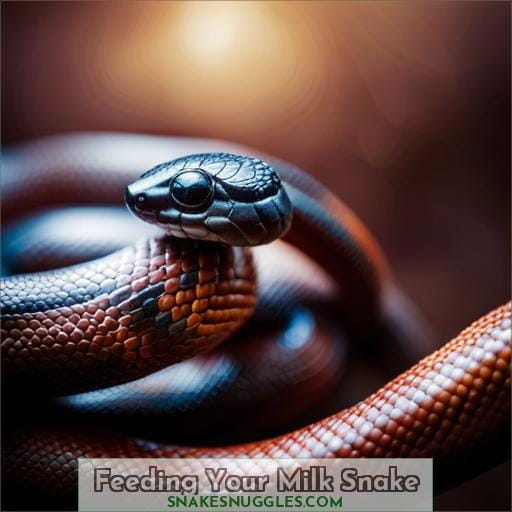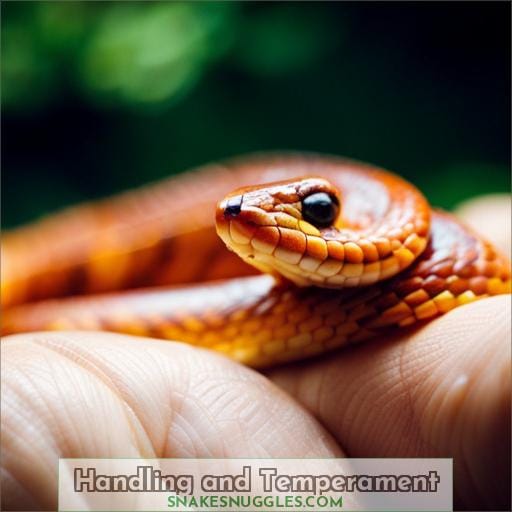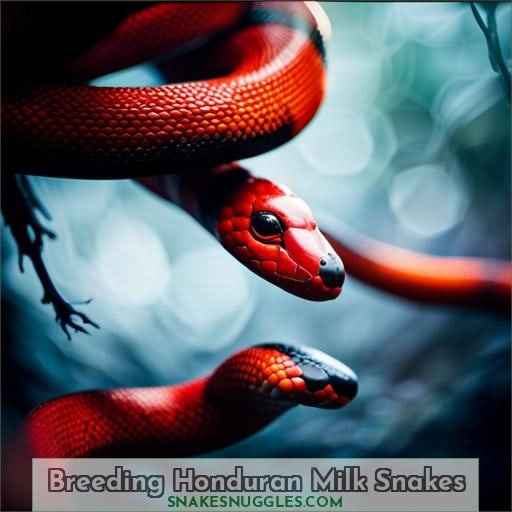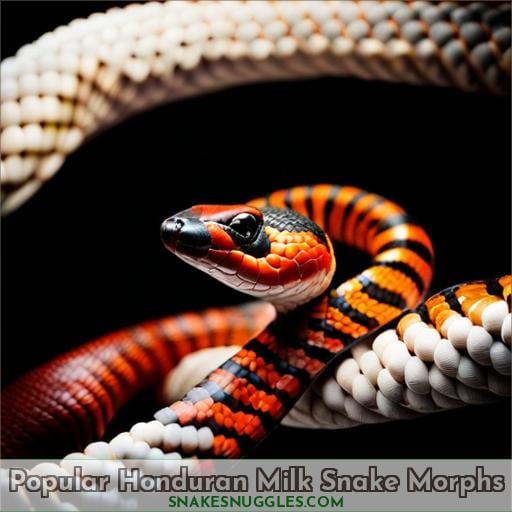This site is supported by our readers. We may earn a commission, at no cost to you, if you purchase through links.
 You’re considering a Honduran Milk Snake?
You’re considering a Honduran Milk Snake?
These lovely snakes are native to Central America and are quite popular in the herpetoculture community.
Their docile nature makes them excellent pets for experienced and novice keepers alike.
In this care guide, you’ll discover everything you need to know about their housing, feeding, health, and popular morphs.
Let’s embark on this journey together and ensure your Honduran Milk Snake thrives in your care.
Table Of Contents
- Key Takeaways
- Honduran Milk Snake Facts
- Housing Your Milk Snake
- Heating and Lighting
- Humidity and Hydration
- Enclosure Decor and Substrates
- Feeding Your Milk Snake
- Handling and Temperament
- Honduran Milk Snake Health
- Breeding Honduran Milk Snakes
- Popular Honduran Milk Snake Morphs
- Frequently Asked Questions (FAQs)
- What are some common health issues I should watch out for in my Honduran milk snake?
- How often should I clean my Honduran milk snake’s enclosure and what is the best way to clean it?
- What signs should I look for if my Honduran milk snake is ready to shed its skin?
- What are some recommended enrichment activities I can provide for my Honduran milk snake?
- How can I transport my Honduran milk snake safely if I need to take it to the vet or move homes?
- Conclusion
Key Takeaways
- Provide proper enclosure size and environment – minimum 48x18x18 inches, temperature gradient 75-95°F, humidity 50-60%.
- Offer appropriate lighting – UVB lighting 10-12 hours per day, thermal gradient with basking area at 100°F.
- Feed an appropriate diet – thawed frozen/thawed mice or rats, sized not wider than snake’s body, every 5-7 days for juveniles, 7-10 days for adults.
- Allow proper hydration – sturdy, spill-proof water bowl, mist enclosure daily to maintain humidity.
Honduran Milk Snake Facts
With your Honduran milk snake, you’re caring for a large, docile snake originating from the tropical forests of Central America.
Found in Honduras, Nicaragua, and northern Costa Rica, these snakes inhabit humid forests and grasslands.
Their coloration features red, black, and yellow/white bands mimicking the venomous coral snake.
Honduran milk snakes reach 4-5 feet on average, but can grow over 6 feet long.
They’re solitary, nocturnal predators that ambush small mammals, lizards, and birds as prey.
When threatened, they may bite or release a foul-smelling musk.
Provide proper housing with adequate humidity and temperatures from 75°F on the cool end to 95°F on the warm end.
Overall, milk snakes have a docile temperament when handled respectfully.
Housing Your Milk Snake
To properly house your Honduran Milk Snake, you’ll need a spacious and secure vivarium that meets their specific needs.
A minimum enclosure size of 48x18x18 inches provides adequate room for an adult. However, larger enclosures allow for more comfortable living spaces.
Hatchlings can start in smaller habitats but should be moved to an adult-sized one by 6 months old.
Avoid housing multiple milk snakes together since they’re cannibalistic.
Proper housing includes:
- A temperature gradient between 75-95°F
- UVB lighting to enable healthy calcium metabolism
- Appropriate humidity around 50-60% to prevent dehydration
Ensure the environment has hiding areas using décor elements like rocks, wood, and plants to make your milk snake feel secure.
With the right enclosure setup, you can provide a healthy home that may even allow for breeding.
Heating and Lighting
You’ll need to provide your milk snake with proper heating and lighting to maintain its health.
As an ectotherm, regulating its body temperature depends on having access to adequate heat sources.
Use undertank heat pads, ceramic heat emitters, or incandescent bulbs to create a thermal gradient from 75-85°F on the cool end to 85-95°F on the warm end, with a basking area reaching 100°F.
Monitor temperatures using a quality thermostat, adjusting heating as needed.
Additionally, provide 10-12 hours per day of UVB lighting to enable proper calcium metabolism and prevent metabolic bone disease.
Ensure lighting fixtures are working properly through regular inspection and bulb replacement every 6 months.
Following these heating and lighting guidelines will promote optimal health and activity levels for your Honduran milk snake.
Humidity and Hydration
To create a humid environment and maintain optimal temperature, consider setting up a thermal gradient, with a 5-10°C difference between the cool side temperature guidelines. Once your heating is set up properly, maintaining the right humidity levels in your milk snake’s enclosure is crucial.
You’ll want to keep the humidity between 50-60% to prevent dehydration or respiratory infections.
Use a hygrometer to monitor it, and make adjustments as needed with mist systems, moisture-retaining substrates, or water bowls.
Providing a humid hide box can aid hydration and shedding.
Simply place damp sphagnum moss or coconut fiber in a secure hide for your snake to crawl into when it needs a hydration boost.
Misting once a day also helps mimic the natural humidity of a Honduran milk snake’s tropical climate.
Proper humidity encourages complete sheds and keeps their scales from drying out.
With some adjustments to match the numbers on your hygrometer, you’ll be able to provide the ideal hydration for your milk snake’s health and happiness.
Enclosure Decor and Substrates
Your Honduran milk snake’s enclosure should contain decor elements like branches and artificial plants to create a natural habitat and hiding places.
Substrates like aspen shavings or cypress mulch hold humidity and allow for burrowing.
Providing ample climbing opportunities with branches and vines allows your snake to exhibit its natural arboreal behaviors.
Cypress mulch or coconut fiber substrates retain humidity well while allowing your milk snake to burrow and feel secure.
Clean the enclosure regularly, spot clean daily, and replace substrates every 2-3 months.
Adding elements like hollow logs, stacked rocks, and artificial foliage promotes natural behaviors and provides environmental enrichment.
A proper substrate and diverse mix of decor create a comfortable, secure, and stimulating habitat that meets the physical and psychological needs of your Honduran milk snake.
Feeding Your Milk Snake
Most of the time, you’re going to feed your Honduran milk snake thawed frozen/thawed mice or rats of an appropriately sized prey item.
Offer food once every 5-7 days for juveniles, and 7-10 days for adults.
Variety is important, rotate between mice and rats of the same relative size. Prey should be no wider than the widest part of the snake’s body.
Cool temperatures can reduce appetite and slow digestion, while overly warm temperatures can increase the risk of regurgitation.
Avoid handling your snake for at least 48 hours after feeding to allow proper digestion and prevent regurgitation.
Monitoring weight and body condition will help guide appropriate prey size selection and feeding frequency for optimal Honduran milk snake health.
Provide water at all times in a sturdy, spill-proof bowl, changing it daily.
Handling and Temperament
When it comes to handling your Honduran milk snake, you’ll find their temperament depends on regular gentle handling from a young age.
As juveniles, they may be somewhat nippy and flighty.
However, with careful, deliberate sessions of handling, allowing the snake to move freely between both hands, their behavior gradually improves.
Try scooping the snake gently and cupping it, letting it grow accustomed to your scent and temperature.
Persistence pays off; daily short handling sessions of 5-10 minutes, paired with a calm and reassuring manner, will lead an otherwise defensive snake to tolerate and even enjoy human interaction.
An adult well-socialized Honduran milk snake that associates handling with security makes for a docile, beautiful pet.
Honduran Milk Snake Health
As solitary predators, milk snakes thrive with proper nutrition and husbandry.
Offer feeder rodents of appropriate size every 5-7 days, providing a balanced calcium-phosphorus ratio.
Seek veterinary care if your snake loses appetite or weight.
Quarantine new snakes for 90 days, monitoring stool samples for parasites.
Prevent respiratory infections with proper temperatures and humidity.
Regularly inspect skin for retained shed, blisters, lesions, or scale rot.
Provide a soak bowl to support hydration and shedding.
Alert a qualified herp vet promptly about discharge, wheezing, bubbles, or other abnormalities.
Your attentiveness ensures your milk snake remains vigorous and long-lived.
Through conscientious care, handling technique, and prompt treatment, you safeguard its health.
Breeding Honduran Milk Snakes
To breed Honduran milk snakes:
- Brumate them for around 3 months over the winter.
- After brumation, the snakes will begin displaying increased feeding behavior.
- The females will then lay eggs 6-10 weeks later, usually after a pre-lay shed cycle.
- Typical clutch sizes range from 4-15 eggs, with the average being 8-10 eggs.
- Place the eggs in a sealed plastic box with moistened vermiculite.
Brumation
Prior to mating, you’ll need to expose the snakes to a 3-month winter brumation period.
This is done by lowering the enclosure temperatures into the 70s.
This brumation period provides seasonal adaptation benefits, inducing a dormant state that slows the snakes’ metabolism and behaviors.
The hibernation-like brumation readies Honduran milk snakes for springtime mating by mimicking natural cyclical environmental changes.
Mating and Egg Laying
To breed Honduran Milk Snakes, you’ll need to understand their mating and egg-laying behaviors.
After 3 months of brumation, the snakes will exhibit increased feeding and mating behaviors.
Females lay clutches of 4-15 eggs about 6-10 weeks after successful mating.
The eggs then incubate on moist vermiculite at 80-85°F for 60-90 days before hatching.
Parental care ends once the eggs are laid.
Hatching
One incubates the eggs at 80-85°F for approximately 60-90 days before the hatchlings emerge from their eggs.
Monitor humidity levels in the incubation container to prevent the eggs from drying out.
Once hatched, house the neonates individually to prevent cannibalism.
Work with experienced breeders to promote genetic diversity in captive populations while responsibly meeting market demand for popular color morphs.
Popular Honduran Milk Snake Morphs
The most popular morphs of the Honduran milk snake include the tricolor, tangerine, and albino varieties.
These color and pattern mutations are commonly bred in captivity for the pet trade, offering keepers more options while still maintaining the Honduran milk snake’s docile temperament and manageable size.
Let’s take a closer look at some of the details around these Honduran milk snake morphs that enthusiasts and breeders should know about:
Tricolor
You’ll recognize the classic tricolor Honduran milk snake by its deep red base color marked with distinct cream to orange bands bordered by black.
As the most common color variety, the vibrant contrast mimics deadly coral snakes as protection.
Conservationists work to preserve fragile forest ecosystems sheltering these docile snakes.
When caring for this morph, provide proper heating, humidity, housing, and a balanced rodent diet to maintain their health.
Tangerine
The tangerine morph features vibrant orange bands in place of the usual red and black bands.
This variation results from selective breeding to intensify the orange pigmentation.
Tangerine Hondurans remain one of the most sought-after color morphs among hobbyists for their bright, attention-grabbing tones.
Their prevalence in the pet trade signals the species’ captive breeding success while threatening conservation of wild populations.
Responsible hobbyists should support initiatives benefiting native habitats.
Albino
Your Honduran milk snake’s albino morph lacks the typical red and black pigmentation, exhibiting a white or yellow coloration with pink or ruby eyes instead.
Albino genetics prevent melanin production, resulting in little to no black or red coloration.
Their bright white and yellow hues stand out beautifully, but albinos lack camouflage and face greater threats from predators.
Providing extra hideouts helps reduce stress and support their wellbeing.
Frequently Asked Questions (FAQs)
What are some common health issues I should watch out for in my Honduran milk snake?
Respiratory infections,
Parasites,
Scale rot,
Mouth rot,
and improper shedding.
How often should I clean my Honduran milk snake’s enclosure and what is the best way to clean it?
Monthly cleaning is ideal for your milk snake’s home.
Start by removing all decor and substrate.
Then, thoroughly disinfect the enclosure with a mild bleach solution.
Rinse well, allow to dry fully, add fresh substrate and decor.
Once the environment is ready, return your snake.
This regular maintenance prevents disease.
What signs should I look for if my Honduran milk snake is ready to shed its skin?
As your Honduran milk snake nears a shed:
- Look for its eyes turning blue-grey and its colors dulling.
- Its body may appear wrinkled or flaky.
Provide a humid hide box to aid the shedding process.
Regular misting can also help.
What are some recommended enrichment activities I can provide for my Honduran milk snake?
Provide climbing branches, hiding places, and different substrates for burrowing.
Allow supervised exploration outside the enclosure.
Change décor periodically to stimulate natural curiosity and hunting behaviors.
How can I transport my Honduran milk snake safely if I need to take it to the vet or move homes?
When transporting your Honduran milk snake:
- Use an escape-proof container like a pillowcase or plastic tub.
- Limit transportation times.
- Provide temperature regulation.
- Avoid sudden movements to minimize stress on your snake.
Handle carefully and keep the enclosure:
- Dark
- Quiet
Conclusion
Show your Honduran milk snake love by providing proper housing, temperature, humidity, enrichment, and a varied diet.
With gentle handling and routine wellness checks, your docile snake will thrive.
As you watch your milk snake grow, reflect on the bond formed through respectful captive care.
Though challenging at times, the joys of herpetoculture reward the diligent hobbyist.

